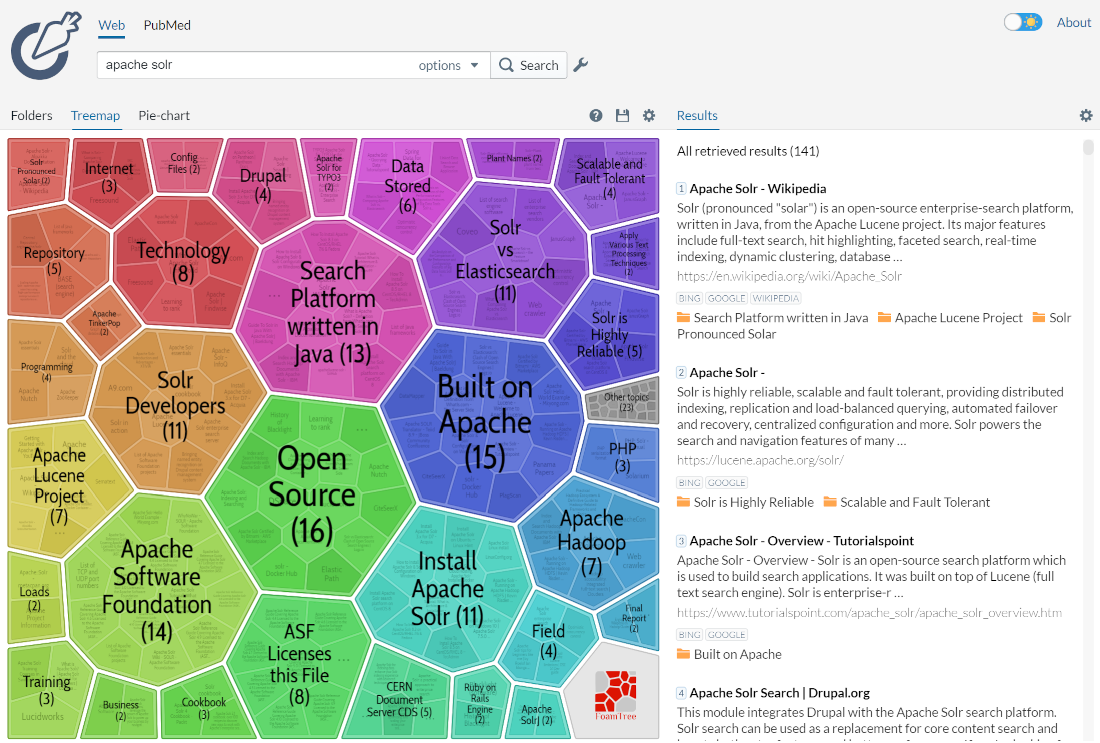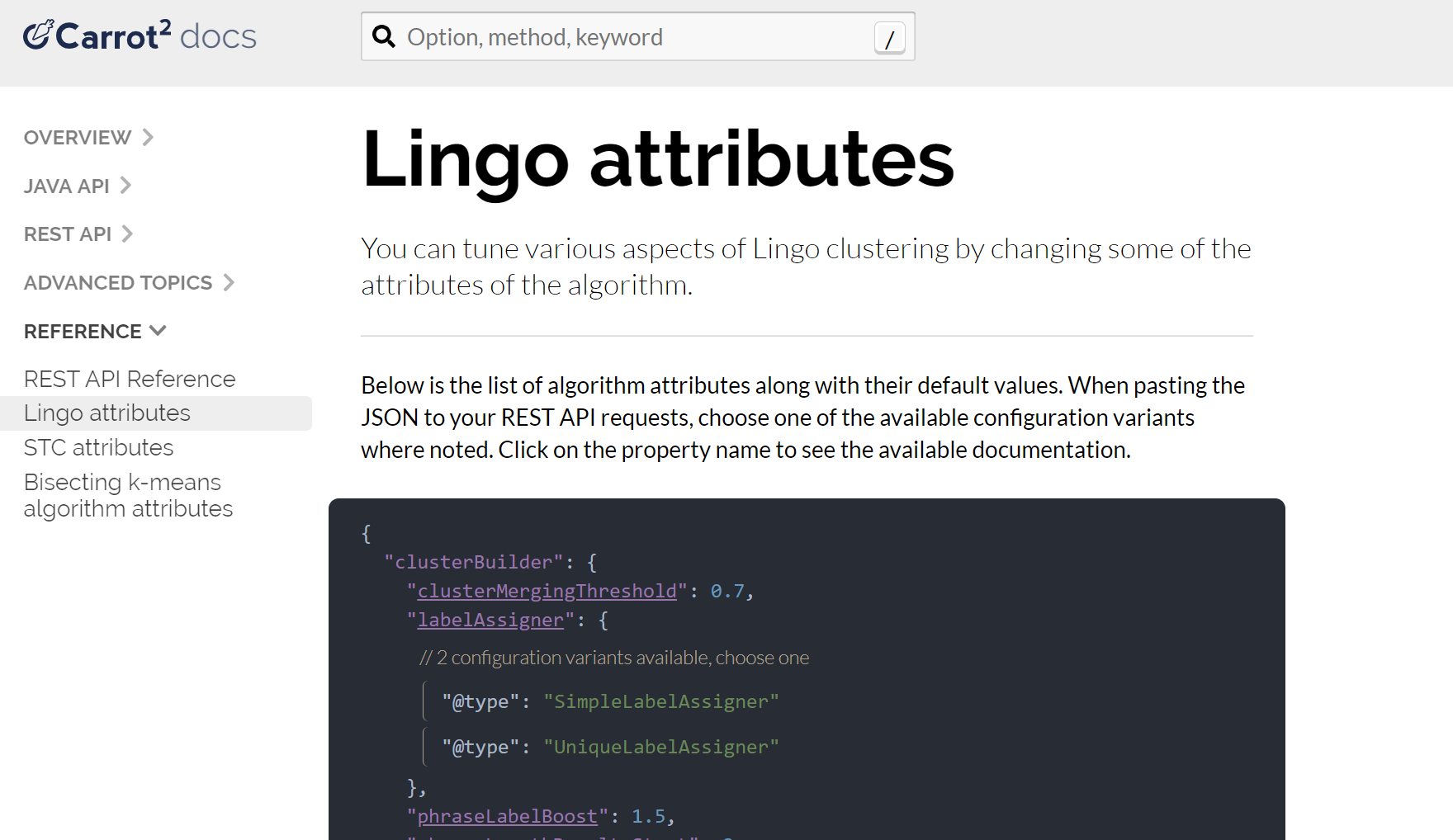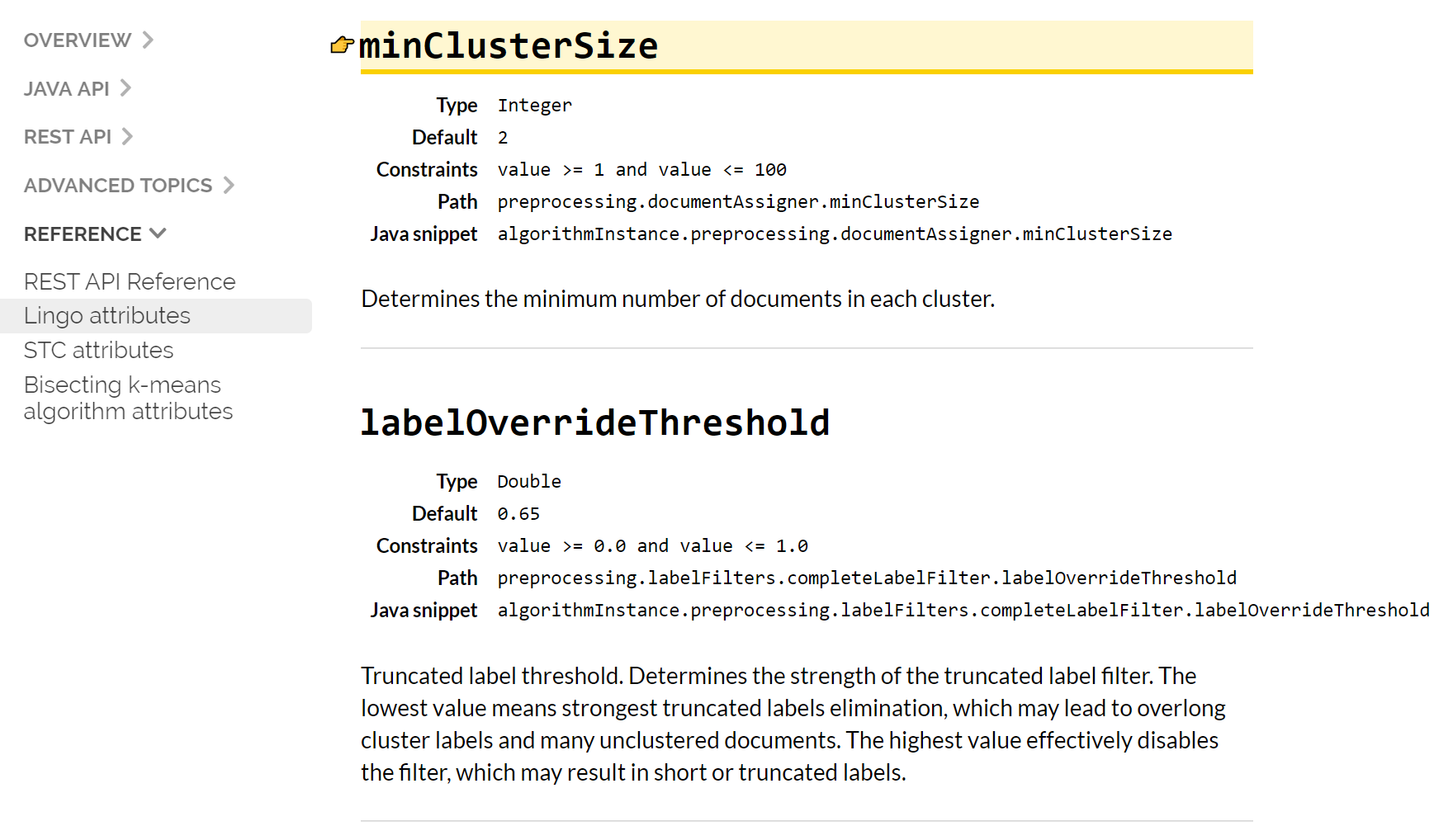Result Clustering
|
The clustering component implementation and API (parameters) have changed significantly in version 9.0. Please refer to the Solr Guide version matching your Solr release exactly. |
The clustering (or cluster analysis) plugin attempts to automatically discover groups of related search hits (documents) and assign human-readable labels to these groups.
The clustering algorithm in Solr is applied to documents included in search result of each single query -— this is called an on-line clustering.
Clusters discovered for a given query can be perceived as dynamic facets. This is beneficial when regular faceting is difficult (field values are not known in advance) or when the queries are exploratory in nature. Take a look at the Carrot2 project’s demo page to see an example of search results clustering in action (the groups in the visualization have been discovered automatically in search results to the right, there is no external information involved).

The query issued to the system was Apache Solr. It seems clear that faceting could not yield a similar set of groups, although the goals of both techniques are similar — to let the user explore the set of search results and either rephrase the query or narrow the focus to a subset of current documents. Clustering is also similar to Result Grouping in that it can help to look deeper into search results, beyond the top few hits.
Module
This is provided via the clustering Solr Module that needs to be enabled before use.
Configuration Quick Starter
The clustering extension works as a search component.
It needs to be declared and configured in solrconfig.xml, for example:
<searchComponent class="org.apache.solr.handler.clustering.ClusteringComponent" name="clustering">
<lst name="engine">
<str name="name">lingo</str>
<str name="clustering.fields">title, content</str>
<str name="clustering.algorithm">Lingo</str>
</lst>
</searchComponent>The above declares the clustering component with a single engine — there may be multiple engines declared and switched at runtime. We will return to the details of how to configure engines later.
The clustering component must be attached to a SearchHandler and explicitly enabled via property clustering.
It is important to attach it as the last component in the handler’s pipeline, as shown below:
<requestHandler name="/select" class="solr.SearchHandler">
<lst name="defaults">
<bool name="clustering">true</bool>
<str name="clustering.engine">lingo</str>
</lst>
<arr name="last-components">
<str>clustering</str>
</arr>
</requestHandler>Once attached, as in the example above, the clustering will be performed automatically
on all documents matching the search handler’s query.
The clustering extension will take into
account all text fields listed in clustering.fields parameter of the engine and will
product a section of the response called clusters containing the discovered structure of
groups, for example (JSON response for brevity):
{
"clusters": [
{
"labels": ["Memory"],
"score": 6.80,
"docs":[ "0579B002",
"EN7800GTX/2DHTV/256M",
"TWINX2048-3200PRO",
"VDBDB1A16",
"VS1GB400C3"]},
{
"labels":["Coins and Notes"],
"score":28.560285143284457,
"docs":["EUR",
"GBP",
"NOK",
"USD"]},
{
"labels":["TFT LCD"],
"score":15.355729924203429,
"docs":["3007WFP",
"9885A004",
"MA147LL/A",
"VA902B"]}
]
}The labels element of each cluster is a dynamically discovered phrase that describes and applies to all document identifiers under docs element.
Solr Distribution Example
The "techproducts" example included with Solr is pre-configured with all the necessary components for result clustering — but they are disabled by default.
To enable the clustering component extension and the dedicated search handler configured to use it, specify a JVM System Property when running the example:
bin/solr start -e techproducts -Dsolr.clustering.enabled=trueYou can now try out the clustering handler by opening the following URL in a browser:
http://localhost:8983/solr/techproducts/clustering?q=*:*&rows=100&wt=xml
The output XML should include search hits and an array of automatically discovered clusters at the end, resembling the output shown here:
<response>
<lst name="responseHeader">
<int name="status">0</int>
<int name="QTime">299</int>
</lst>
<result name="response" numFound="32" start="0" maxScore="1.0">
<doc>
<str name="id">GB18030TEST</str>
<str name="name">Test with some GB18030 encoded characters</str>
<arr name="features">
<str>No accents here</str>
<str>这是一个功能</str>
<str>This is a feature (translated)</str>
<str>这份文件是很有光泽</str>
<str>This document is very shiny (translated)</str>
</arr>
<float name="price">0.0</float>
<str name="price_c">0,USD</str>
<bool name="inStock">true</bool>
<long name="_version_">1448955395025403904</long>
<float name="score">1.0</float>
</doc>
<!-- more search hits, omitted -->
</result>
<arr name="clusters">
<lst>
<arr name="labels">
<str>DDR</str>
</arr>
<double name="score">3.9599865057283354</double>
<arr name="docs">
<str>TWINX2048-3200PRO</str>
<str>VS1GB400C3</str>
<str>VDBDB1A16</str>
</arr>
</lst>
<lst>
<arr name="labels">
<str>iPod</str>
</arr>
<double name="score">11.959228467119022</double>
<arr name="docs">
<str>F8V7067-APL-KIT</str>
<str>IW-02</str>
<str>MA147LL/A</str>
</arr>
</lst>
<!-- More clusters here, omitted. -->
<lst>
<arr name="labels">
<str>Other Topics</str>
</arr>
<double name="score">0.0</double>
<bool name="other-topics">true</bool>
<arr name="docs">
<str>adata</str>
<str>apple</str>
<str>asus</str>
<str>ati</str>
<!-- other unassigned document IDs here -->
</arr>
</lst>
</arr>
</response>A few clusters discovered for this query (*:*), separate all search hits into various categories: DDR, iPod, Hard Drive, etc.
Each cluster has a label and score that indicates the "goodness" of the cluster.
The score is algorithm-specific and is meaningful only in relation to the scores of other clusters in the same set.
In other words, if cluster A has a higher score than cluster B, cluster A should be of better quality (have a better label and/or more coherent document set).
Each cluster has an array of identifiers of documents belonging to it.
These identifiers correspond to the uniqueKey field declared in the schema.
Sometimes cluster labels may not make much sense (this depends on many factors — text in clustered fields, number of documents, algorithm paramerters).
Also, some documents may be left out and not be clustered at all; these will be assigned to the synthetic Other Topics group, marked with the other-topics property set to true (see the XML dump above for an example).
The score of the other topics group is zero.
Configuration
Component Configuration
The following properties control ClusteringComponent state.
clustering-
Optional
Default:
falseThe component is by default disabled, even if properly declared and attached to a search handler. The
clusteringproperty must be set totrueto enable it. This can be done by setting up default parameters in the search handler as described in the next section. clustering.engine-
Optional
Default: see description
Declares which engine to use. If not present, the first declared active engine is used.
Clustering Engines
The declaration of clustering component in solrconfig.xml must include one or more predefined configurations called engines.
For example, consider the configuration below:
<searchComponent class="org.apache.solr.handler.clustering.ClusteringComponent" name="clustering">
<lst name="engine">
<str name="name">lingo</str>
<str name="clustering.algorithm">Lingo</str>
<str name="clustering.fields">title, content</str>
</lst>
<lst name="engine">
<str name="name">stc</str>
<str name="clustering.algorithm">STC</str>
<str name="clustering.fields">title</str>
</lst>
</searchComponent>This declares two separate engines (lingo and stc): these configurations have a different clustering algorithm, and a different set of clustered document fields.
The active engine can be selected by passing clustering.engine=name parameter at runtime (via URL) or as the default within the search handler’s configuration, as shown below:
<requestHandler name="/clustering" class="solr.SearchHandler">
<lst name="defaults">
<!-- Clustering component enabled. -->
<bool name="clustering">true</bool>
<str name="clustering.engine">stc</str>
<!-- Cluster the top 100 search results - bump up the 'rows' parameter. -->
<str name="rows">100</str>
</lst>
<!-- Append clustering at the end of the list of search components. -->
<arr name="last-components">
<str>clustering</str>
</arr>
</requestHandler>Clustering Engine Configuration Parameters
Each declared engine can be configured using a number of parameters described below.
clustering.fields-
Required
Default: none
A comma (or space) separated list of text fields which should contain the text content for clustering. At least one field must be provided. The fields are separate from search handler’s
flparameter so that clustered fields don’t have to be included in the response. clustering.algorithm-
Required
Default: none
The clustering algorithm is the actual logic (implementation) that discovers relationships among the documents and forms human-readable cluster labels. This parameter sets the name of the clustering algorithm this engine is going to use. Algorithms are supplied to Solr via Carrot2-defined service extension. By default, the following open-source algorithms should be available:
Lingo,STC,Bisecting K-Means. A commercial clustering algorithmLingo3Gplugs into the same extension point and can be used, if it is available on classpath.
clustering.maxLabels-
Optional
Default: none
Maximum number of returned cluster labels (if the algorithm returns more labels, the list will be truncated). By default all labels are returned.
clustering.includeSubclusters-
Optional
Default: none
If
true, sub-clusters are included in the response for algorithms that support hierarchical clustering.falsecauses only top-level clusters to be returned. clustering.includeOtherTopics-
Optional
Default:
trueIf
true, a synthetic cluster called Other Topics, consisting of all documents not assigned to any other cluster is formed and returned. If there is no need for this synthetic cluster, it can be set tofalse. clustering.resources-
Optional
Default: none
Location of algorithm-specific resources and configuration files (stop words, other lexical resources, default settings). This property is
nullby default and all resources are read from their respective algorithm default resource pool (JARs). If this property is not empty, it resolves relative to Solr core’s configuration directory. This parameter can be applied during Solr startup only, it can’t be overriden per-request.
There are more properties applying to engine configuration. We describe these in functional sections that follow.
Full Field and Query-Context (Snippet) Clustering
The clustering algorithm can consume full content of fields or just the left and right context around query-matching regions (so-called snippets). Contrary to the intuition, using query contexts can increase the quality of clustering even if it feeds less data to the algorithm. This is typically caused by the fact that snippets are more focused around the phrases and terms surrounding the query and the algorithm has a better signal-to-noise ratio of data to work with.
We recommend using query contexts when fields contain a lot of content (this would affect clustering performance).
The following three properties control whether the context or full content are processed and how snippets are formed for clustering.
clustering.preferQueryContext-
Optional
Default: none
If
true, the engine will try to extract context around the query matching regions and use these contexts as input for the clustering algorithm. clustering.contextSize-
Optional
Default: none
The maximum size, in characters, of each snippet created by the context retrieval algorithm (internal highlighter).
clustering.contextCount-
Optional
Default: none
The maximum number of different, non-contiguous snippets from a single field.
Default Clustering Language
The default implementations of clustering algorithms in Carrot2 (shipped with Solr) have built-in support (stemming, stop words) for preprocessing a number of languages. It is important to provide the clustering algorithm with a hint of what language should be used for clustering. This can be done in two ways — by passing the name of the default language or by providing the language as a field with each document. The following two engine configuration parameters control this:
clustering.language-
Optional
Default:
EnglishName of the default language to use for clustering. The provided language must be available and the clustering algorithm must support it.
clustering.languageField-
Optional
Default: none
Name of the document field that stores the document’s language. If the field does not exist for a document or the value is blank, the default language is used.
The list of supported languages can change dynamically (languages are loaded via external service provider extension) and may depend on the selected algorithm (algorithms can support a subset of languages for which resources are available). The clustering component will log all supported algorithm-language pairs at Solr startup, so you can inspect what’s supported on your particular Solr instance. For example:
2020-10-29 [...] Clustering algorithm Lingo3G loaded with support for the following languages: Dutch, English
2020-10-29 [...] Clustering algorithm Lingo loaded with support for the following languages: Danish, Dutch, English, Finnish, French, German, Hungarian, Italian, Norwegian, Portuguese, Romanian, Russian, Spanish, Swedish, Turkish
2020-10-29 [...] Clustering algorithm Bisecting K-Means loaded with support for the following languages: Danish, Dutch, English, Finnish, French, German, Hungarian, Italian, Norwegian, Portuguese, Romanian, Russian, Spanish, Swedish, TurkishHandling Multilingual Content
It is often the case that the index (and query result) contains documents in multiple languages. Clustering such search results is problematic. Ideally, the engine should translate (or understand) the content of documents and then group relevant information together, regardless of the language it is written in.
In reality, clustering algorithms are typically much simpler — they infer similarity between documents from statistical properties of terms and phrases that occur in those documents. So texts written in different languages will not cluster too well.
To deal witht his situation the default clustering component implementation in Solr will try to first group all documents by their language and then apply clustering to each sub-group in that language.
It is recommended to store the language of each document as its separate field and point at it using the clustering.languageField configuration property described above.
Tweaking Algorithm Settings
The clustering algorithms that come with Solr use their default parameter values and language resources. We highly recommend tuning both for production uses. Improving the default language resources to include words and phrases common to a particular document domain will improve clustering quality significantly.
Carrot2 algorithms have an extensive set of parameters and language resource tuning options. Please refer to up-to-date project documentation. In particular, the language resources section and each algorithm’s attributes section.
Changing Clustering Algorithm Parameters
Clustering algorithm settings can be changed via Solr parameters either permanently (in the Engine’s declaration) or per-request (via Solr URL parameters).
For example, let’s assume the following engine configuration:
<lst name="engine">
<str name="name">lingo</str>
<str name="clustering.algorithm">Lingo</str>
<str name="clustering.fields">name, features</str>
<str name="clustering.language">English</str>
</lst>First, locate the configuration parameters for the Lingo algorithm at Carrot2 documentation site:

Then locate the particular setting you’d like to change and note the
REST API path to that setting (in this case the parameter is
minClusterSize and its path is preprocessing.documentAssigner.minClusterSize):

Now add the full path-value pair to the engine’s configuration:
<lst name="engine">
<str name="name">lingo</str>
<str name="clustering.algorithm">Lingo</str>
<str name="clustering.fields">name, features</str>
<str name="clustering.language">English</str>
<int name="preprocessing.documentAssigner.minClusterSize">3</int>
</lst>The following rules apply.
-
The type of the parameter must be consistent with the type listed in Carrot2 specification.
-
If the parameter is added to the engine’s configuration in
solrconfig.xml, the core must be reloaded for the changes to be picked up. Alternatively, pass the parameter via the request URL to change things dynamically on a per-request basis. For example, if you have the "techproducts" example running, this will cut the clusters to only those containing at least three documents:http://localhost:8983/solr/techproducts/clustering?q=*:*&rows=100&wt=json&preprocessing.documentAssigner.minClusterSize=3 -
For complex types, the parameter key with the name of the instantiated type must precede any of its own parameters.
Custom Language Resources
Clustering algorithms rely on language and domain-specific language resources to improve the quality of clusters (by discarding domain-specific noise and boilerplate language).
By default, language resources are read from the engine-declared algorithm default JAR.
You can pass a custom location for these resources by specifying the clustering.resources parameter.
The value of this parameter resolves to a location relative to Solr core’s configuration directory.
For example, the following definition:
<lst name="engine">
<str name="name">lingo</str>
<str name="clustering.algorithm">Lingo</str>
<str name="clustering.fields">name, features</str>
<str name="clustering.language">English</str>
<str name="clustering.resources">lingo-resources</str>
</lst>would result in the following log entry and expected resource location:
Clustering algorithm resources first looked up relative to: [.../example/techproducts/solr/techproducts/conf/lingo-resources]The best way to start tuning algorithm resources is to copy all the defaults from its corresponding Carrot2 JAR file (or Carrot2 distribution).
Performance Considerations
Clustering of search results comes with some performance considerations:
-
The cost of fetching a larger-than-usual number of search results (50, 100 or more documents),
-
Additional computational cost of the clustering itself.
-
In distributed mode the content of document fields for clustering is collected from shards and adds some additional network overhead.
For simple queries, the clustering time will usually dominate everything else. If document fields are very long, the retrieval of stored content can become a bottleneck.
The performance impact of clustering can be lowered in several ways.
-
Cluster less data: use query context (snippets) instead of full field content (
clustering.preferQueryContext=true). -
Perform clustering on just a subset of document fields or curate fields for clustering (add abstracts at indexing-time) to make the input smaller.
-
Tune the performance attributes related directly to a specific algorithm.
-
Try a different, faster algorithm (STC instead of Lingo, Lingo3G instead of STC).
Additional Resources
The following resources provide additional information about the clustering component in Solr and its potential applications.
-
Clustering and Visualization of Solr search results (Berlin BuzzWords conference, 2011): http://2011.berlinbuzzwords.de/sites/2011.berlinbuzzwords.de/files/solr-clustering-visualization.pdf